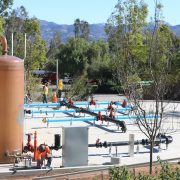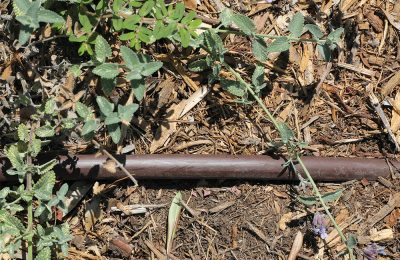College Students Get Their Feet Wet at New Center for Water Studies
RANCHO SAN DIEGO – Cutting-edge training facilities unveiled for spring classes at Cuyamaca College help tomorrow’s water and wastewater workforce gain the hands-on experience necessary for successful careers in the industry. Additional upgrades are on the way by fall, as the college continues expanding its legacy of preparing workers for careers in water.
Cuyamaca’s new Center for Water Studies features an innovative Field Operations Skills Yard – an above-ground water distribution system and an underground wastewater collection system that provides students with practical challenges they will face in today’s complex water and wastewater facilities.
“These fully operational water and wastewater systems will be used to replicate many of the entry-level tasks employees perform as they begin their careers in the water and wastewater industry,” said Don Jones, who helped spearhead the creation of the Center for Water Studies. “It’s the culmination of a many years long pipe dream.”
Cuyamaca students also will benefit from a $1 million renovation to Water & Wastewater Technology program facilities, including a water quality analysis classroom and a shop area for backflow prevention and cross-connection control training. Renovations started this spring with completion anticipated by fall 2018.
Skilled water professionals are in high demand as the current workforce ages. Water and wastewater agencies employ more than 60,000 workers statewide, including 5,000 in San Diego County, according to the federal Bureau of Labor Statistics (BLS). But the Water Research Foundation and the American Water Works Association anticipate one-third of the current water utilities workforce nationwide will retire over the next decade, offering numerous opportunities for 20-somethings to start careers.
The industry offers other benefits. In San Diego County, wastewater treatment and system operators earn an average annual wage of more than $66,000, according to the federal BLS.
Filling the Water Career Pipeline
Cuyamaca College’s Water & Wastewater Technology program is the oldest and most comprehensive program of its kind in the California Community Colleges system, educating the state’s water utility workforce for more than a half a century. In the 2016-2017 academic year, 35 students at Cuyamaca earned associate’s degrees or certificates in water and wastewater fields.
The college works closely with local water agencies, and the new Center for Water Studies evolved through discussions among members of the Cuyamaca College Water & Wastewater Technology Program Industry Advisory Committee. The committee comprises representatives from the City of San Diego Public Utilities Department, the San Diego County Water Authority, Helix Water District, Padre Dam Municipal Water District, the City of Escondido Utilities Department, Olivenhain Municipal Water District and other agencies.
Funding for the recent upgrades at Cuyamaca comes from several sources:
- A California Community College Strong Workforce grant provided $192,000 for the Field Operations Skills Yard.
- A grant from the National Science Foundation provided $72,000 for the skills yard.
- Grossmont-Cuyamaca Community College District’s Proposition V, approved by voters in 2012, provided $1 million for renovating classroom space.
Cuyamaca College has received a $900,000 National Science Foundation grant to encourage Grossmont Union High School District (GUHSD) students to consider careers in water and wastewater. Those funds also will help recruit veterans, women and students from underrepresented communities to start careers in water and wastewater management.
GUHSD and water industry experts currently are collaborating on lesson plans related to water and wastewater management skills for local high school science classes. High school teachers will be invited to activities at the Center for Water Studies as soon as this summer – another way that Cuyamaca’s investment is paying off for the community.





